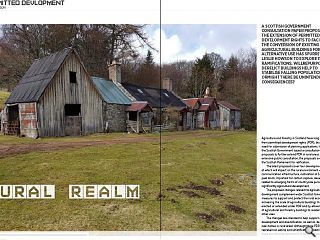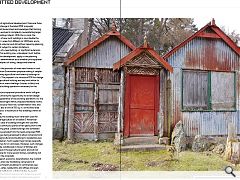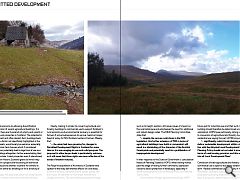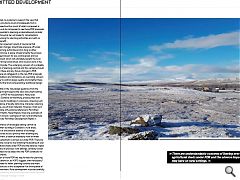Permitted Development: Rural Realm
21 Apr 2021
A Scottish Government consultation paper proposing the extension of permitted development rights to facilitate the conversion of existing agricultural buildings for alternative use has spurred Leslie Howson to explore its ramifications. Will repurposing derelict buildings help to stabilise falling populations or might there be unintended consequences?
Agriculture and forestry in Scotland have long benefited from permitted development rights (PDR), thus avoiding need for submission of planning applications. In 2020, the Scottish Government issued a consultation paper on proposals to further extend PDR in rural areas. Following an extensive public consultation, the proposals are now with the Scottish Parliament for ratification. The latest proposals cover four development types, all of which will impact on the rural environment viz: digital communication infrastructure, restoration of Scottish peat lands, important for carbon capture, developments related to emerging forms of countryside pursuits and most significantly agricultural development.
The proposed changes relevant to agricultural development complement wider Scottish Government measures to support and protect the rural economy by increasing the scale of agricultural buildings that may be erected or extended under PDR and by allowing conversion of agricultural and forestry buildings to residential and other uses. The changes are intended to help support agricultural development and diversification, as well as deliver more new homes in rural areas. Although these PDR changes represent an easing and simplification of planning control, there are still prior restrictions to be met as planning safeguards.
In respect of agricultural development, there are three main areas of change in the latest PDR proposals The Scottish Government acknowledges that farming practices have evolved in complexity necessitating larger agricultural buildings (sheds). With this in mind, the maximum size of new such buildings is now double the previous limit ( n area from 465sqm to 1,000sqm; and a 20% increase in volume) and still without requiring planning approval, albeit subject to certain limitations. In the case of a new building, or significant extension or alteration of an existing one, a developer must, before commencing the development, apply to the planning authority for a determination as to whether prior approval is required in respect of sitting, design and external appearance. To support the provision of more new homes in rural areas, the Scottish Government propose making it simpler to convert existing agricultural and forestry buildings to residential use. The proposal is to introduce PDR for change of use of an agricultural building and any land within its curtilage to one or more dwellings (houses or flats) and the reasonable building operations necessary for the conversion.
However, a prior approval procedure would still give the planning authority the opportunity to review design and external appearance of any building operations viz. the provision of natural light within proposed habitable rooms; transport and access; flood risk; contamination risks; and noise. There is also a limit of 150 sq. m. on the floor area of each home and a maximum of five dwellings within an agricultural unit. Importantly, the building must have been used for the purposes of agriculture on or before 5 November 2019; or, in the case of buildings brought into use after that date, for a continuous period of ten years prior to the conversion taking place. Listed buildings and scheduled monuments are excluded from the newly proposed PDR.
The PDR changes being proposed to allow conversion and extensions of agricultural and buildings to residential uses will no doubt deliver much needed new homes especially affordable homes for in rural areas. However, such changes should surely be conditioned in favour of families and workers involved in the agricultural sector and will not become a vehicle for more second homes, something not fully evident in the proposals. To help support economic diversification, the Scottish Government is also now facilitating conversions of agricultural and forestry buildings to commercial uses such as shops, cafés, restaurants, and offices and even non-residential institutions, which includes museums and galleries. The Scottish Government states the overall aim of these changes is to help to stimulate and support Scotland`s rural economy by allowing diversification through conversion of vacant agricultural buildings. It is estimated that there are thousands of empty and vacant or former agricultural properties in Scotland.
The potential to bring many vacant and often derelict farm buildings back into use, albeit a factor not specifically highlighted in the new PDR proposals, would surely be welcome, especially as many are former farm houses which if considered `abandoned` can potentially lead to legal loss of use as a residential dwellings altogether, further exacerbating their already ruinous state. Listed properties even if abandoned, may benefit from Historic Scotland grant aid which may help to kick start a project and the easing of restriction under PDR could prove another incentive for owners to begin restoration either as dwellings or for a diversity of other uses. These changes now proposed, albeit still under review, are the subject of much controversy and have raised a number of issues . Clearly, making it simpler to convert agricultural and forestry buildings to commercial use to support Scotland`s rural economy and environmental recovery is essential for farmers if some businesses are to survive. Gemma Cooper head of policy for NFU Scotland writes in Farmers Weekly, that: ‘... the union had been pressing for changes to PDR in Scotland for some time so it is encouraging to see such solid progress.
The proposal to allow larger sheds is particularity welcome as it will mean that these rights are more reflective of the needs of modern industry’. The Royal Incorporation of Architects in Scotland have spoken of the likely detrimental effects on rural areas, erosion of housing standards and of design quality and the impact on character of rural areas hamlets and villages and towns. The size increase proposed for larger agricultural buildings albeit restrictions will be in place, such as to height, position, still raises issues of impact on the rural landscape and emphasises the need for additional and robust design codes. The RIAS Planning Committee, state that: ‘... despite the various restrictions in the PDR legislation, this further extension of PDR in terms of agricultural buildings (new build or conversion) will result in a diminishing of the character of the Scottish Countryside and potentially result in a proliferation of inappropriate development’. In their response to the Scottish Government`s consultation Heads of Planning Scotland (HOPS) whilst having moved past the stage of raising further comments, expressed concerns about protection of landscape, especially in sensitive designations such as National Parks and National Scenic areas.
On the matter of larger agricultural buildings, HOPS have concerns are about such large buildings being in future put for industrial uses and that such increase scale of building should therefore be determined under a planning application. HOPS have particularly strong objections to conversion of agricultural and forestry buildings to residential use saying this part of PDR proposals would: ‘… significantly restrict local planning authorities to deliver sustainable development within a local setting in line with the Adopted Local Development Plan . Scottish Planning Policy should set out what is acceptable in terms of rural housing provision and this would be built into all Local Development Plans’. Conversion of both agricultural and forestry buildings to commercial use is open to too many variations and the term `flexible commercial use ` is surely in itself vague. Developers seeking to speculate via these new PDR proposals by erecting large sheds for the sole purpose of later re purposing , albeit there is a 10 year limit in the PDR conditions, has to be of concern. HOPS noted no evidence to support the view that existing PDR provisions are at all inadequate from a Planning perspective thus much of what is proposed is unnecessary and do not appear to see these PDR proposals as a process parallel to planning as desirable and consider that adding this extra tier will make for complications be time consuming for planning authorities and with no quantifiable benefit .
The counter argument would of course be that these particular changes should take pressure off under resourced planning authorities and as long as other relevant controls are in place, should simplify the process of obtaining permission for less controversial and low level development which will ultimately benefit the rural economy for farmers and others who live and work in the Scottish countryside. The underlying concern of is probably about erosion of planning controls and this certainly should be ensured in these and any future changes to PDR. Whilst there are safeguards in the new PDR proposals by way of conditions and limitations, an overriding concern has to be how to control design quality and whether there is a need for further and compensating/ additional design guidelines. There is little in the way design guidance from the Scottish Government beyond the basic document setting out the limits of PDR for householders. Many local authorities in Scotland do thankfully, produce their own design guidance for buildings in rural areas, stressing such as the importance of locally distinctive character, retaining sense of place, use of local materials.
However, most such documents make only passing reference to Permitted Development Rights. Nevertheless, there are examples of good ( as well as bad ) examples of new rural architecture carried out under Permitted Development Rights in Scotland. The importance of landscape setting cannot be over stated when building in Scotland`s rural areas, consideration of the sensitive balance of buildings and landscape has to be a priority when allowing any new development; a balance debatably more at threat wherever development is carried out under PDR. There are understandable concerns over allowing the building of ever larger agricultural sheds under PDR and the adverse impact these may have on precious rural settings; certainly screen planting will need to be added into the PDR conditions for such developments. Is provision of more PDR the way forward for planning controls in Scotland or, as HOPS suggest, even necessary?
Such rights make for fewer planning controls and more freedom to build but is this acceptable if at the expense of our rural environment. Rural development must be carefully monitored by planning and future decisions made with rural Scotland`s landscape heritage in mind.
|
|






